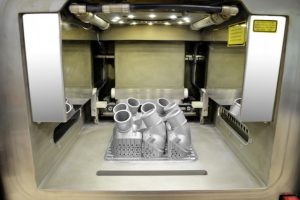 The Mercedes-Benz Trucks division of Daimler has printed its first spare part made of metal. The thermostat cover, which is produced in small numbers for older trucks and Unimog models, was 3D-printed from a die-cast aluminium alloy and has passed testing for original part quality, according to the truckmaker.
The Mercedes-Benz Trucks division of Daimler has printed its first spare part made of metal. The thermostat cover, which is produced in small numbers for older trucks and Unimog models, was 3D-printed from a die-cast aluminium alloy and has passed testing for original part quality, according to the truckmaker.
The company said production of metal parts directly from digital data files saved tooling, storage and transport costs. It added that 3D metal printing could lead to decentralised local production of parts at any global location, which would improve parts availability.
“Expensive warehousing and the associated, complex transport processes would be unnecessary, with delivery times made shorter for customers,” said Mercedes-Benz Trucks in a statement.
Mercedes-Benz Trucks began 3D printing for aftersales and replacement parts in its Customer Services and Parts division a year ago and said the 3D printing of high-quality plastic components, following research and development with Daimler, was now established as an additional production method suitable for small batches. According to Daimler, the printing of metal parts builds on this development well because the process can produce high strength and thermal resistant parts, and is therefore particularly suitable for the production of mechanically and thermally stressed components.
The truckmaker highlighted areas where the parts could be used, including peripheral and ‘in-engine’ parts, as well as those in cooling systems, transmissions, axles and chassis.
“Especially when they have complex structures, 3D-printed metal parts in small numbers can be produced cost-effectively as infrequently requested replacement parts, special parts and for small and classic model series,” said the company in a statement.
It added that, thanks to advancing digitisation, even highly specific metal components could be ordered from Mercedes-Benz Trucks and delivered anywhere in the world cost effectively and to quality standards on request, even after many years.
As outlined at the recent Automotive Logistics Europe conference in Bonn, Germany, the opportunities for automotive in the 3D printing market are primarily in the service management supply chain, which is traditionally a very costly area because parts have to be made anywhere, at any time and in any quantity.

























![Global[1]](https://d3n5uof8vony13.cloudfront.net/Pictures/web/a/d/s/global1_726550.svgz)









